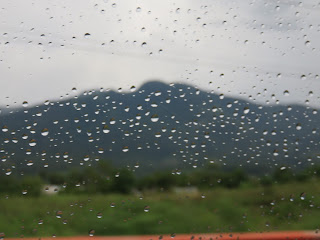Rainwater harvesting
Universal, affordable access to potable water does not exist in El Salvador, particularly in rural areas. One partial solution to the problem is rainwater harvesting --- when the rains fall abundantly on El Salvador, there is plenty of fresh water, if it can be captured, stored and made accessible.
A recent article from IPS News describes some rainwater harvesting projects in El Salvador:
Filling a jug with water to supply her household needs used to be an ordeal for Salvadoran villager Corina Canjura, because it meant walking several kilometers to the river, which took up a great deal of time, or else paying for water.
But an innovative project of rainwater harvesting has changed her life.
“Now we just pump, fill the tank and we have water ready to use,” said the 30-year-old woman from the village of Los Corvera, in the rural municipality of Tepetitán, in El Salvador’s central department of San Vicente.
In this village, 13 families benefit from a system that collects the rainwater that falls on the roof of Canjura’s house, which is then channeled through a pipe into a huge polyethylene bag, with a capacity of 25,000 liters.
From there, it is manually pumped into a tank with a faucet used by all of the families.Read the rest of the article here.
“Since it has rained a lot, the bag is always full, which is a joy for us,” Canjura told IPS, while carrying a jug on her head which she had just filled.
One major challenge for such systems is the storage of water for the dry seasons. With six dry months following six wet months, few small, local systems can safely store and maintain a sufficient quantity of water to last during the dry periods. In the community system described in the IPS article, the local municipality is going to supplement the rainwater with trucked in water during the dry season.
A paper prepared by the OAS provides a good overview of the considerations involved in the design and operation of rainwater harvesting systems. Included in the paper is this list of advantages and disadvantages:
Advantages
- Rainwater harvesting provides a source of water at the point where it is needed. It is owner operated and managed.
- It provides an essential reserve in times of emergency and/or breakdown of public water supply systems, particularly during natural disasters.
- The construction of a rooftop rainwater catchment system is simple, and local people can easily be trained to build one, minimizing its cost.
- The technology is flexible. The systems can be built to meet almost any requirements. Poor households can start with a single small tank and add more when they can afford them.
- It can improve the engineering of building foundations when cisterns are built as part of the substructure of the buildings, as in the case of mandatory cisterns.
- The physical and chemical properties of rainwater may be superior to those of groundwater or surface waters that may have been subjected to pollution, sometimes from unknown sources.
- Running costs are low.
- Construction, operation, and maintenance are not labor-intensive.
- The success of rainfall harvesting depends upon the frequency and amount of rainfall; therefore, it is not a dependable water source in times of dry weather or prolonged drought.
- Low storage capacities will limit rainwater harvesting so that the system may not be able to provide water in a low rainfall period. Increased storage capacities add to construction and operating costs and may make the technology economically unfeasible, unless it is subsidized by government.
- Leakage from cisterns can cause the deterioration of load bearing slopes.
- Cisterns and storage tanks can be unsafe for small children if proper access protection is not provided.
- Possible contamination of water may result from animal wastes and vegetable matter.
- Where treatment of the water prior to potable use is infrequent, due to a lack of adequate resources or knowledge, health risks may result; further, cisterns can be a breeding ground for mosquitoes.
- Rainfall harvesting systems increase construction costs and may have an adverse effect on home ownership. Systems may add 30% to 40% to the cost of a building.
- Rainfall harvesting systems may reduce revenues to public utilities.

Comments